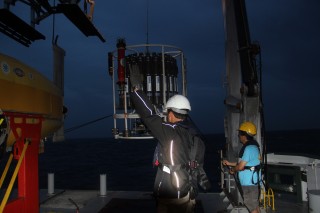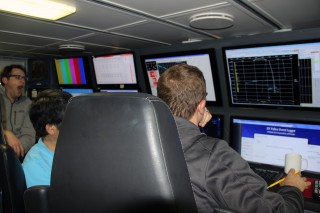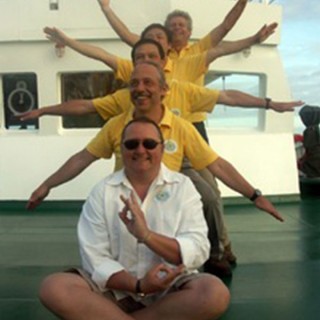I have a cold.
Yuk.
I suspect I am not alone and given that there are about 50 of us all living close in one another’s company, I likely won’t be the last. But right now I feel pretty grotty.
Still, so long as you wipe down your screens after reading this, hopefully you won’t catch it from me. Least ways, that was how I used to think you catch a virus.
But today, Cody taught me different.

The way you catch a cold might well begin with getting up in the dark at 5am and then standing out on deck in the pouring rain. Certainly that was how we started the day today for a CTD launch right over the Von Damm hydrothermal field. We lowered our CTD package down through the water column while the officers on the Bridge nudged the ship ever closer to the top of the mound at the location we had given them. To do this as accurately as possible we had one of the navigation beacons on the CTD telling us where it was, as well as where the ship was, at all times. By the time the CTD was down at the depth of the vent-site, the center of the ship was about 20m SE of the summit of the mound and the CTD was about 10-20m to the NW – but 2,500m away at the other end of a wire! Our “drivers” can “park” really well ☺
Throughout the whole deployments we saw no hydrothermal signals in any of our sensors except one – the Eh sensor that Ko-ichi Nakamura has brought on this cruise which yielded very clear indications of exactly where the most chemically “fresh” hydrothermal plume waters were. Armed with that information, we tripped 12 of our 24 bottles all at the same depth so that Cody can process all the material so-collected to examine them for viruses as well as the bacteria and archaea that have been studied in hydrothermal plumes before. Then, we raised the CTD higher in the water column to get comparable samples of background seawater samples. This is one of very few studies we know of, to-date, studying viruses in hydrothermal systems. Not a bad way to spend your first 3 hours on site at these vent-sites!

After drawing all the samples on deck, we occupied a second station, about 5km away to the NW from the hydrothermal field, in mid-afternoon. Everything looked exactly the same apart from Ko-ichi’s Eh sensor trace – we had lost our plume signals completely in just a matter of hours just by driving 5km away.
Wish I could lose my cold that fast.
Overnight tonight we are calibrating our navigation systems for the ship and Nereus ready to start some serious diving action. The AUV team are getting up at 3am tomorrow to start working their way meticulously through their pre-dive check list ready for launching Nereus off the back deck just before first light at 6am. Check back tomorrow for how that goes!

